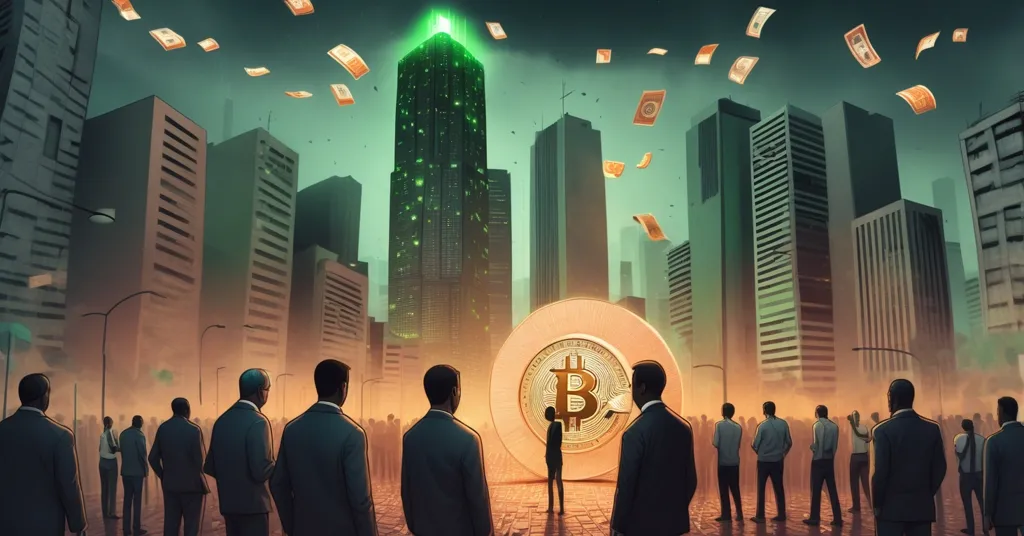Brazil’s 15% Rate Standoff: Inflation Battle Fuels Bitcoin and Crypto Appeal

Brazil’s Central Bank Stands Firm at 15%: Inflation Fights and Crypto’s Quiet Call
Brazil’s central bank has doubled down, holding the benchmark Selic interest rate at a punishing 15%—a level not seen in nearly two decades—for the third straight meeting. Led by Gabriel Galipolo, this move is a gritty stand against stubborn inflation that’s still miles above the 3% target, with forecasts warning it could linger into 2028. But as economic growth sputters and political maneuvers heat up ahead of elections, the cracks in centralized finance are glaring. Could this be another nudge for Bitcoin and decentralized tech to step into the spotlight?
- Rate Lock: Selic rate frozen at 15%, matching economist predictions.
- Inflation Grip: Prices still rising, far from the 3% goal through 2028.
- Political Plays: Lula’s spending and tax cuts spark fiscal fears.
- Crypto Angle: Centralized flaws fuel the case for Bitcoin and beyond.
Brazil’s Economic Standoff: A 15% Hammer on Growth
For those new to the term, the Selic rate is Brazil’s key interest rate, set by the central bank to manage inflation and borrowing costs. At 15%, it’s a brutal tool—making loans expensive to slow spending and cool price rises, but also choking economic momentum. This isn’t a sudden decision; the bank jacked up rates by 4.5 percentage points from September last year to June this year, desperate to tame inflation that’s been a persistent headache for Latin America’s largest economy. The latest data shows consumer prices climbing 0.48% in September, a jump from August’s 0.11% drop, pushing the yearly rate to 5.17%. That’s nowhere near the 3% target, even with a 1.5% wiggle room. Some relief comes from food and beverage prices, which fell 0.26% in September for the fourth month running, thanks to better supply as noted by Fernando Goncalves of the Brazilian Institute of Geography and Statistics (IBGE).
The household food group continues to show negative variations, given the greater supply of products. — Fernando Goncalves, IBGE Research Manager
But don’t get too cozy. Other pressures are piling up. Record-low unemployment sounds great, but it’s driving wage growth that keeps inflation simmering. Businesses are struggling with tight credit, and overall activity is grinding down. Meanwhile, global headwinds like volatile commodity prices and a strong US dollar add extra strain on an economy already wrestling with internal supply chain hiccups. Mario Mesquita, chief economist at Itaú Unibanco Holding SA, captures the central bank’s bind perfectly.
The combination of a cautious stance in the face of a still uncertain external environment and the assessment that the lagged effects of monetary policy are still unfolding. — Mario Mesquita, Chief Economist at Itaú Unibanco Holding SA
What he’s saying is simple: the bank knows high rates don’t hit the brakes instantly—it takes months for their dampening effect to fully kick in. They’re betting on patience, even if it means short-term pain for growth. Yet, with Brazil’s debt-to-GDP ratio hovering around 78% (per recent IMF data) and GDP growth forecasts slashed to under 2% for 2023, this gamble could backfire if the slowdown deepens. For more on the central bank’s stance, check out the detailed report on Brazil holding steady at a 15% rate amidst ongoing inflation challenges.
Political Wildcards: Lula’s Cash Splash Raises Eyebrows
Enter President Luiz Inácio Lula da Silva, who’s stirring the pot with fiscal moves that could either save the day or sink the ship. With a general election looming, his government just passed a bill hiking the income tax exemption threshold from 3,036 reais to 5,000 reais ($930) monthly. The idea? More cash in people’s pockets to boost spending and counter the economic drag from sky-high rates. Add to that a flurry of social spending programs—think expanded welfare and infrastructure pushes—and you’ve got a classic populist playbook. Short-term, it might prop up struggling households. Long-term? It’s a debt bomb waiting to detonate.
Investors are nervous, and for good reason. Brazil’s public finances are already shaky, with fiscal deficits projected to widen if these policies aren’t matched by revenue gains. Andres Abadia from Pantheon Macroeconomics offers a cautious nod to the inflation outlook, but fiscal risks loom large.
The overall picture remains benign. September’s mild rebound mainly reflects base effects, while forward-looking indicators point to continued disinflation in the months ahead. — Andres Abadia, Chief Latin America Economist at Pantheon Macroeconomics
Translation: inflation might ease a bit due to temporary factors (base effects mean last year’s numbers make this year’s look worse by comparison), but Lula’s spending spree could reignite price pressures down the line. This tug-of-war between a hardline central bank and a vote-hungry administration reeks of dysfunction. It’s the kind of mess that makes you question who’s really steering the ship—and whether the system itself is the problem.
The Crypto Conversation: Centralized Chaos Meets Decentralized Hope
This is where the flaws of centralized finance scream loudest. When a central bank can crush growth with rate hikes, and a politician can gamble a nation’s future on pre-election handouts, trust in the system erodes. For many in Brazil, and across emerging markets, this is the spark that ignites interest in Bitcoin and decentralized finance (DeFi). Bitcoin’s fixed supply of 21 million coins means no government can inflate it away to fund pet projects. It’s a middle finger to monetary meddling—a store of value for those burned by currency devaluation. And with the Brazilian real bolstered by high rates (up roughly 5% against the USD this year), short-term stability might mask deeper issues that drive folks to alternatives.
But let’s slam the brakes on the hype train. Bitcoin isn’t a magic fix for Brazil’s woes. Volatility is a real gut punch—its price swings can wipe out savings faster than inflation. Adoption is another hurdle; only about 3% of Brazilians own crypto, per recent Statista surveys, due to patchy infrastructure and regulatory gray zones. Past crackdowns, like 2019’s tax reporting mandates, haven’t helped build confidence. Then there’s the digital divide—millions lack internet access or smartphones to even touch a crypto wallet. We’re not peddling fantasies here; real change needs real groundwork.
Beyond Bitcoin, platforms like Ethereum offer DeFi tools that could tackle Brazil’s financial exclusion. Smart contracts—self-executing agreements on the blockchain—could slash remittance costs for the unbanked, who often pay 10% or more in fees to send money home. With Brazil’s fintech scene booming (think Pix, the instant payment system), there’s fertile ground for blockchain to accelerate financial access. Aligning with effective accelerationism (e/acc), pushing tech adoption hard and fast could leapfrog sluggish traditional reforms. But move too quick without oversight, and you risk scams and meltdowns—don’t fall for shills swearing crypto will “save” Brazil overnight. It’s a tool, not a savior.
Critical Takeaways: Unpacking Brazil’s Mess and Crypto’s Role
- Why is Brazil’s central bank stuck on a 15% rate?
They’re hell-bent on crushing inflation above 5%, even if it means stunting growth, fearing any easing could unleash price spikes again. - How do high interest rates impact Brazil’s economy?
They slow borrowing and spending, dragging down business activity and GDP growth, but prop up the Brazilian real for now against global volatility. - Are Lula’s fiscal policies a help or a hindrance?
Tax exemptions and social spending might lift consumers short-term, but they risk ballooning debt and undermining the bank’s inflation fight. - Why does this chaos boost the case for Bitcoin?
Centralized control and policy clashes erode trust, making Bitcoin’s independence a tempting hedge against government overreach and currency games. - What stops crypto from being Brazil’s silver bullet?
Volatility, low adoption (just 3% ownership), poor infrastructure, and regulatory uncertainty keep Bitcoin and altcoins on the sidelines for most. - Could Ethereum or DeFi make a difference here?
Yes, by cutting costs for remittances and banking the unbanked via smart contracts, though scaling tech access and trust remains a massive barrier. - How does Brazil compare to other emerging markets for crypto?
It’s a mixed bag—fintech growth offers promise, but economic instability and digital divides lag behind leaders like Nigeria in crypto uptake.
Brazil’s economic grind at 15% interest rates paints a raw picture of centralized finance’s limits. The central bank’s iron grip aims to slay inflation, but at what cost to growth? Lula’s cash handouts might buy votes, yet they flirt with fiscal ruin. For crypto advocates, this mess underscores why decentralization matters—systems ruled by human whims and political chess games beg for alternatives. Bitcoin and Ethereum aren’t quick fixes; they’re messy, unpolished tools facing steep climbs in places like Brazil. Still, as traditional finance stumbles, the conversation around blockchain’s potential only gets louder. Keep watching—this clash of old and new money has chapters yet unwritten.



